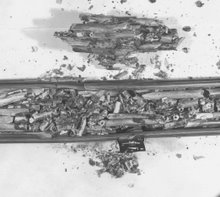News the EPRI bulletin
Mike Howard said, "This is a tremendous accomplishment for the Nuclear Sector and the Materials Group. The savings to the nuclear industry is worth more than the total annual dues to EPRI’s Nuclear Sector."
August 31, 2007
NRC Approves EPRI Pressurizer Weld Crack Growth Analysis, Maintaining Spring Outage Schedule for Nine PWRs through Efforts of EPRI's Materials Reliability Program
By Christine King
Nine reactors will maintain their scheduled spring 2008 plant outages after receiving Nuclear Regulatory Commission’s notification last week that an accelerated schedule is not required to address potential pressurizer pipe weld cracking. The NRC based their decision on the results of the EPRI Materials Reliability Program’s (MRP) analysis of hypothetical circumferential cracking in welds located in the pressurizer spray, surge and safety/relief lines. The NRC considered moving these outages to some time this year for inspection or mitigation of these weld locations. NRC concerns arose from the discovery of indications of possible circumferential cracks at the Wolf Creek plant during its fall 2006 outage. The NRC had issued Confirmatory Action Letters to the nine utilities that confirmed their individual commitments to accelerate their outages if MRP’s analysis did not provide reasonable assurance that current inspection schedules were sufficient.
On the industry’s behalf, MRP performed finite element analyses to determine if such indications would show detectable leakage prior to structural failure given the potential concern for growing circumferential stress corrosion cracks. Leakage would alert operators to the condition, enabling them to take effective corrective action prior to structural failure of the piping. The investigation reconsidered the typical assumption of maintaining a semi-elliptical flaw shape as the flaw grows in the finite element model. In the MRP analysis, the crack was allowed to grow at each point along the crack front to the degree dictated by the local stress conditions producing an evolving crack shape as the crack penetrates through the pipe wall. This crack shape evolution is protypical to what happens in the field. The results demonstrated that the semi-elliptical flaw shape assumption is overly conservative and that a realistic crack will locally penetrate the pipe wall producing leakage without resulting in total pipe failure.
On August 23, the NRC confirmed that by their evaluation, reasonable assurance of safe operation until the next scheduled refueling outage has been demonstrated. This project has been a excellent opportunity for EPRI's MRP to show how we can work well with the NRC to support both NRC and industry when faced with difficult decisions associated with aging degradation in operating nuclear power plants.
Mike Howard said, "This is a tremendous accomplishment for the Nuclear Sector and the Materials Group. The savings to the nuclear industry is worth more than the total annual dues to EPRI’s Nuclear Sector."
Friday, August 31, 2007
Subscribe to:
Post Comments (Atom)

No comments:
Post a Comment